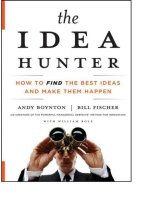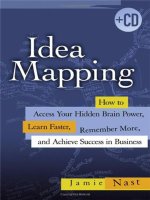The Idea Hunter: How to Find the Best Ideas and Make them Happen
Bạn đang xem bản rút gọn của tài liệu. Xem và tải ngay bản đầy đủ của tài liệu tại đây (1.33 MB, 375 trang )
Table of Contents
Title Page
Copyright Page
Dedication
Preface
Introduction
Already Out There
Ready to Unlearn
CHAPTER 1 - Know Your Gig
The Discernment
The Circle of Competence
Gigs Matter
Interested
CHAPTER 2 - Be Interested, Not Just Interesting
Curiosity at the Trading Post
Learning Machines
Your Brain Is Open
Defining Your Own Hunt
Diverse
CHAPTER 3 - Diversifying the
Hunt
The Color of Your Ideas
When Weak Ties Are Strong
Widening Your Intel ectual Bandwidth
Bridging Distant Worlds
Ideas Are Everywhere
Exercised
CHAPTER 4 - Mastering the Habits of the Hunt
The Practice of Ideas
Begin with an Eye
Observing at the Ritz
Erecting a Personal Platform of Observation
Write It Down
Get It Moving
Observe Yourself
Agile
CHAPTER 5 - Idea Flow Is Critical
The Case of the Guitar Strings
Creating Idea Spaces at Pixar
Finding the “Informal Bosses”
Letting Ideas Percolate
When It’s Time to “Kil ” Ideas
CHAPTER 6 - Create Great
Conversations
“Continuers” and “Terminators”
The Value of a Naïve Question
Preparing for the Big Conversation
EPILOGUE
REFERENCES
Acknowledgments
ABOUT THE AUTHORS
INDEX
This constitutes a continuation of the copyright
page:
“Boynton and Fischer get right to the heart of what
it takes for people to create a superb idea—the
first step to any successful innovation. By
describing the characteristics of successful Idea
Hunters, they provide guidance and tools that wil
increase your capacity to find great ideas and put
them into play.”
—Michael Raynor, director, Deloitte Consulting
LLP, and author, The Strategy Paradox and The
Innovator’s Manifesto
“My company aims to add about $4 bil ion in new
sales every year. This won’t be possible without
everyone in the organization contributing new
ideas. The Idea Hunter is an essential guide to
systematical y developing this critical capability.”
—Werner Geissler, vice chairman, global
operations, Procter & Gamble
“Thril ing, fun, and inspiring, The Idea Hunter tel
s stories and discerns patterns of behavior and
habits shared by the great innovators of the past
century. It finds similarities among the greats
ranging from Warren Buffet to Steve Jobs, and
even going back earlier in the century to Walt
Disney and Thomas Edison. Through brief stories
and simple self-reflection exercises, this book
distil s the quirky essence of leading imagination in
a way we can consume it, and hopeful y aspire to
become one with it.”
—Aaron C. Sylvan, serial entrepreneur and
technologist, One Technology, Trust Works,
LemonadeHeroes, and Sylvan Social Technology
“We rely on using the ideas of thousands of experts
to win against tough competition in a crowded
market. Using The Idea Hunter as a trail map, any
leader can win the daily wars of ideas that
differentiate the innovator from the rest.”
—Jack Hughes, chairman and cofounder,
TopCoder, Inc.
“Idea Hunters are normal people, with a normal
life, in a common social context. The only
difference is that they have an open mind and are
skil ed in searching. This bril iant book is an ideal
guide to achieve an open mind in our complex
world.”
—Maurizio Marinelli, visual artist and president,
Baskervile Research Center on Communication,
Bologna, Italy
“Observe, ask questions, be curious, dare to throw
odd ideas into a group’s conversation to make it
better. These are al ways to ensure that the blind
spots that we al are threatened by do not stay blind.
Be an Idea Hunter!”
—Ton Büchner, CEO, Sulzer, Ltd.
“In my company, I ask al of our team members to
be business owners. Doing things in a better way,
at lower costs, and in a more customer-friendly
way requires ideas from everyone. Those ideas
come from great Idea Hunters throughout the
company, regardless of rank and title. The Idea
Hunter is not only an enjoyable read; it also offers
a practical method so that anyone or any firm can
learn the secrets of harnessing the power of ideas
to drive success.”
—Laura J. Sen, president and CEO, BJ’s
Wholesale Club
“Humans make progress by discovering new ideas,
but also, importantly, by repurposing the ones that
already exist. Boynton and Fischer show how each
of us can get better at this critical skil —
identifying and reapplying existing ideas.”
—Paul Romer, senior felow, Stanford Institute for
Economic Policy Research
“Hunting is an apt metaphor. Ideas exist
everywhere in the wild. The trick is knowing
where to look for them and how to capture them.
Boynton and Fischer tel us how.”
—Ron Sargent, chairman and CEO, Staples, Inc.
“The Idea Hunter is unique. It’s about curiosity,
agility, and perpetual y hunting for better ideas. It’s
a must-read for anyone who wants to compete and
col aborate more effectively each and every day.”
—Greg Brown, president and CEO, Motorola
Solutions
“This book upends a number of persistent myths
about innovation and what it takes to be an ‘idea
person.’ It shows that what’s required is not
spectacular creativity or remarkable IQ, but
curiosity—not innate genius, but a genuine desire
to engage in a daily search for ideas. The Idea
Hunter wil help transform the way you and your
business operate.”
—Jay Hooley, chairman, president, and CEO,
State Street Corporation
“Ideas are the lifeblood of innovation, and
innovation is the key to growth. Boynton and
Fischer offer powerful and practical advice on
how to
‘jumpshift’ the flow of ideas in your organization.
This book wil become required reading for any
leader intent on shaping a high-performance
organization.”
—Michael D. White, chairman and CEO,
DirecTV
Copyright © 2011 by Andy Boynton, Bill Fischer,
and William Bole. All rights reserved.
Published by Jossey-Bass
A Wiley Imprint
989 Market Street, San Francisco, CA 94103-1741
—www.josseybass.com
No part of this publication may be reproduced,
stored in a retrieval system, or transmitted in any
form or by any means, electronic, mechanical,
photocopying, recording, scanning, or otherwise,
except as permitted under Section 107 or 108 of
the 1976 United States Copyright Act, without
either the prior written permission of the publisher,
or authorization through payment of the appropriate
per-copy fee to the Copyright Clearance Center,
Inc., 222 Rosewood Drive, Danvers, MA 01923,
978-750-8400, fax 978-646-8600, or on the Web
at www.copyright.com. Requests to the publisher
for permission should be addressed to the
Permissions Department, John Wiley & Sons, Inc.,
111 River Street, Hoboken, NJ 07030, 201-748-
6011, fax 201-748-6008, or online at
www.wiley.com/go/permissions.
DeepDive® is the registed trademark of Deloitte
Consulting LLP.
Additional credit lines are listed on page 177.
Readers should be aware that Internet Web sites
offered as citations and/or sources for further
information may have changed or disappeared
between the time this was written and when it is
read.
Limit of Liability/Disclaimer of Warranty: While
the publisher and author have used their best
efforts in preparing this book, they make no
representations or warranties with respect to the
accuracy or completeness of the contents of this
book and specifically disclaim any implied
warranties of merchantability or fitness for a
particular purpose. No warranty may be created or
extended by sales representatives or written sales
materials. The advice and strategies contained
herein may not be suitable for your situation. You
should consult with a professional where
appropriate. Neither the publisher nor author shall
be liable for any loss of profit or any other
commercial damages, including but not limited to
special, incidental, consequential, or other
damages.
Jossey-Bass books and products are available
through most bookstores. To contact Jossey-Bass
directly call our Customer Care Department within
the U.S. at 800-956-7739, outside the U.S. at 317-
572-3986, or fax 317-572-4002.
Jossey-Bass also publishes its books in a variety
of electronic formats. Some content that appears in
print may not be available in electronic books.
Library of Congress Cataloging-in-Publication
Data
Boynton, Andrew C.
The idea hunter: how to find the best ideas and
make them happen / Andy Boynton and Bill
Fischer with William Bole.
p. cm.
Includes bibliographical references and index.
ISBN 978-0-470-76776-4 (cloth); ISBN 978-1-
118-03884-0 (ebk);
ISBN 978-1-118-03885-7 (ebk); ISBN 978-1-118-
03886-4 (ebk)
1. Creative ability in business. 2. Creative
thinking. 3. Success in business. I. Fischer, Bill. II.
Bole, William. III. Title.
HD53.B69 2011
650.1—dc22
2011005783
Asking Marie to marry me was the best idea I
ever had! Kim, Amy, Billy, Sergio, Leah, Nicolas,
Isabella, Mia, and William III are living evidence
that one good idea can give birth to many, many
more.
Also, for my mother, Virginia Fumagalli Fischer,
who rose above an eighth-grade education to
inspire several generations with her love for
ideas. She was a true Idea Hunter!
—Bill
Dear Jane, you are at the heart of the very best
ideas I’ve ever had—let’s start a fire and watch
something tonight (“Maybe a game is on!”), can
we go grab some Indian food, let’s take a walk,
or let’s drive out to Great Point (“and maybe I
can fish for blues!”). You know better than
anyone that those are the ideas I treasure most—
and I only enjoy them with you.
—Andy
PREFACE
Why Hunt?
IDEAS MATTER. We could talk at length about
the impact of blockbuster ideas, like the microchip
and mass production. But one of our favorite
examples has to do with something less celebrated:
coffee cup lids.
Many people have already forgotten the ritual they
used to perform after ordering their latte or
double-shot espresso in a coffee shop. Until fairly
recently, customers often had to fumble around the
counter looking for the right-size lid, because a
medium lid would not do if they were holding a
large cup of cappuccino. Al that changed with the
introduction of one-size-fits-al lids, the product of
an idea that required some tinkering with the
design of the rims of disposable coffee cups.
The notion was just a little one, not often talked
about today. But one economist who appreciates
such things is Paul Romer of Stanford University.
“That smal change in the geometry of coffee cups
means that somebody can save a little time in
setting up the coffee shop, preparing the cups,
getting your coffee, and getting out,” Romer told an
interviewer, explaining how the innovation has
touched both the shops and their customers. He
points out that mil ions of little discoveries like
this, combined with some very big ones, have
exponential y improved the quality of life over the
past century.
There’s a larger point about the value of ideas big
and smal. It has to do with the profound difference
between a thing and an idea, between a mere
object and a creative act. George Bernard Shaw
shed light on this distinction. “If you have an apple
and I have an apple and we exchange these apples,
then you and I wil stil have one apple,” he wrote.
“But if you have an idea and I have an idea and we
exchange these ideas, then each of us wil have two
ideas.” The apple in your hands wil be exactly
what it is (until it is bitten into), but your recipe for
apple crisp, which is an idea, could be used many
times by many people.
Getting back to the coffee shop: the cardboard cup
is a thing. Typicaly a person uses it just once
before tossing it into the recycle bin. The lid is
also a thing. Yet the insight that one lid could fit
cups of al sizes—smal , medium, and large—is not
a thing. It’s an idea. What’s more, it’s an idea that
coffee-shop owners and managers al over the
world can reuse over and over again.
Romer takes up an interesting question: Which is a
bigger obstacle—a shortage of ideas, or a shortage
of things? His research has shown that
“idea gaps,” as he styles them, hold back progress
and innovation much more than the “object gaps.”
He is speaking primarily about how societies have
ultimately risen out of poverty not because of
things, like paper or steel, but because of ideas
about how to leverage those things (for example,









